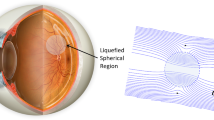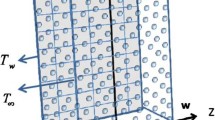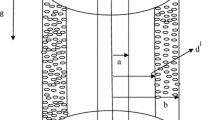Abstract
The present work describes the application of the generalised porous medium model to study heat and fluid flow in healthy and glaucomatous eyes of different subject specimens, considering the presence of ocular cavities and porous tissues. The 2D computational model, implemented into the open-source software OpenFOAM, has been verified against benchmark data for mixed convection in domains partially filled with a porous medium. The verified model has been employed to simulate the thermo-fluid dynamic phenomena occurring in the anterior section of four patient-specific human eyes, considering the presence of anterior chamber (AC), trabecular meshwork (TM), Schlemm’s canal (SC), and collector channels (CC). The computational domains of the eye are extracted from tomographic images. The dependence of TM porosity and permeability on intraocular pressure (IOP) has been analysed in detail, and the differences between healthy and glaucomatous eye conditions have been highlighted, proving that the different physiological conditions of patients have a significant influence on the thermo-fluid dynamic phenomena. The influence of different eye positions (supine and standing) on thermo-fluid dynamic variables has been also investigated: results are presented in terms of velocity, pressure, temperature, friction coefficient and local Nusselt number. The results clearly indicate that porosity and permeability of TM are two important parameters that affect eye pressure distribution.

Velocity contours and vectors for healthy eyes (top) and glaucomatous eyes (bottom) for standing position.















Similar content being viewed by others
Abbreviations
- C f :
-
Skin friction coefficient
- c p :
-
Specific heat (J/g/K)
- Da :
-
Darcy number
- F :
-
Forchheimer coefficient
- g :
-
Gravity (m/s2)
- k :
-
Thermal conductivity (W/m K)
- L :
-
Characteristic length (m)
- n :
-
Normal direction
- Nu L :
-
Local Nusselt number
- p :
-
Pressure (Pa)
- Pr :
-
Prandtl number
- t :
-
Time (s)
- T :
-
Temperature (°C)
- u :
-
Velocity (m/s)
- α :
-
Thermal diffusivity (m2/s)
- β :
-
Thermal expansion coefficient (1/°C)
- ε :
-
Porosity
- κ :
-
Permeability (m2)
- μ :
-
Viscosity (Pa s)
- ρ :
-
Density (kg/m3)
- τ w :
-
Wall shear stress (Pa)
- AC:
-
Anterior chamber
- AH:
-
Aqueous humor
- CC:
-
Collector channel
- HE:
-
Healthy eye
- GE:
-
Glaucomatous eye
- IOP:
-
Intraocular pressure
- SC:
-
Schlemm’s canal
- TM:
-
Trabecular meshwork
- e:
-
Effective
- f:
-
Fluid
- m:
-
Mean
- o:
-
Ocular
- ref:
-
Reference
- s:
-
Solid
References
Quigley HA, Broman AT (2006) The number of people with glaucoma worldwide in 2010 and 2020. Br J Ophthalmol 90:262–267
Johnson M, Mclaren JW, Overby DR (2017) Unconventional aqueous humor outflow: a review. Exp Eye Res 158:94–111
Bill A, Phillips CI (1971) Uveoscleral drainage of aqueous humor in human eyes. Exp Eye Res 12:275–281
Fan BJ, Wiggs JL (2010) Glaucoma: genes, phenotypes, and new directions for therapy. J Clin Investig 120:3064–3072
Braunger BM, Fuchshofer R, Tamm ER (2015) The aqueous humor outflow pathways in glaucoma: a unifying concept of disease mechanisms and causative treatment. Eur J Pharm Biopharm 95:173–181
Dautriche CN, Xie Y, Sharfstein ST (2014) Walking through trabecular meshwork biology: towards engineering design of outflow physiology. Biotechnol Adv 32:971–983
Stamer WD, Braakman ST, Zhou EH, Ethier CR, Fredberg JJ, Overby DR, Johnson M (2015) Biomechanics of Schlemm’s canal endothelium and intraocular pressure reduction. Prog Retin Eye Res 44:86–98
Acott TS, Kelley MJ (2008) Extracellular matrix in the trabecular meshwork. Exp Eye Res 86:543–561
Allingham RR, Dekater AW, Ethier CR, Anderson PJ, Hertzmark E, Epstein DL (1992) The relationship between pore density and outflow facility in human eyes. Investig Ophthalmol Vis Sci 33:1661–1669
Grant WM (1958) Further studies on facility of flow through trabecular meshwork. A.M.A Archives of Ophthalmology. https://doi.org/10.1001/archopt.1958.00940080541001
Moses RA (1979) Circumferential flow in Schlemm’s canal. Am J Ophthalmol 88:585–591
Johnson MC, Kamm RD (1983) The role of Schlemm’s canal in aqueous outflow from the human eye. Investig Ophthalmol Vis Sci 24:320–325
Lutjen-Drecoll E (1973) Structural factors influencing outflow facility and its changeability under drugs. Investig Ophthalmol 12:280–294
Pedrigi RM, Stamer D, Reed A, Overby DR (2011) A model of giant vacuole dynamics in human Schlemm’s canal endothelial cells. Exp Eye Res 92:57–66
Scott PA, Overby DR, Freddo TF, Gong H (2007) Comparative studies between species that do and do not exhibit the washout effect. Exp Eye Res 84:435–443
Braakman ST, Pedrigi R, Read AT, Smith JA, Stamer WD, Ethier CR, Overby DR (2014) Biomechanical strain as a trigger for pore formation in Schlemm’s canal endothelial cells. Exp Eye Res 127:224–235
Ayyalasomayajula A, Park RI, Simon BR, Geest JPV (2016) A porohyperelastic finite element model of the eye: the influence of stiffness and permeability on intraocular pressure and optic nerve biomechanics. Comput Meth Biomech Biomed Eng 19:591–602
Eklund A, Linden C, Backlund T, Andersson BM, Lindahl OA (2003) Evaluation of applanation resonator sensors for intra-ocular pressure measurement: results from clinical and in vitro studies. Med Biol Eng Comput 41:190–197
Avtar R, Srivastava R (2007) Modelling aqueous humor outflow through trabecular meshwork. Appl Math Comput 189:734–745
Avtar R, Srivastava R (2006) Aqueous outflow in Schlemm’s canal. Appl Math Comput 174:316–328. https://doi.org/10.1016/S0096300305004583
Bradley M, Heys JJ (2008) Effect of variable permeability on aqueous humor flow. Appl Math Comput 196:371–380
Wessapan T, Rattanadecho P (2014) Influence of ambient temperature on heat transfer in the human eye during exposure to electromagnetic fields at 900 MHz. Int J Heat Mass Transf 70:378–388
Narasimhan A, Kumar JA, Gopal L (2010) Transient simulations of heat transfer in human eye undergoing laser surgery. Int J Heat Mass Transf 53:482–490
Amara EH (1995) Numerical investigations on thermal effects of laser-ocular media interaction. Int J Heat Mass Transf 38:2479–2488
Ferreira JA, Oliveira PD, Pascoal S, Joaquim M (2014) Numerical simulations of aqueous humor flow: from healthy to pathologic situations. Appl Math Comput 226:777–792
Chen H, Zhang F, Huang Y, Jiankang W (2015) Numerical investigation of topical drug transport in anterior human eye. Int J Heat Mass Transf 85:356–366
Crowder TR, Ervin VJ (2013) Numerical simulations of fluid pressure in the human eye. Appl Math Comput 219:11119–11133
Kapnisis K, Doormaal MV, Ethier CR (2009) Modeling aqueous humor collection from human eye. J Biomech 42:2454–2457
Villamarin A, Roy S, Hasballa R, Vardoulis O, Reymond P, Stergiopulos N (2012) 3D simulation of the aqueous flow in the human eye. Med Eng Phys 34:1462–1470
Xiong G, Zhan J, Zuo K, Li J, Rong L, Xu G (2008) Numerical flow simulation in the post-endoscopic sinus surgery nasal cavity. Med Biol Eng Comput 46:1161–1167
Perez JF, Barea R, Boquete L, Hidalgo MA, Dapena M, Vilar G, Dapena I (2008) Cataract surgery simulator for medical education & finite element/3D human eye model. IFMBE Proc 20:429–432
Deplano V, Bertolotti C, Boiron O (2001) Numerical simulations of unsteady flows in a stenosed coronary bypass graft. Med Biol Eng Comput 39:488–499
Massarotti N, Nithiarasu P, Zienkiewicz OC (2001) Natural convection in porous medium-fluid interface problems: a finite element analysis by using the CBS procedure. Int J Numer Methods Heat Fluid Flow 11(5):473–490
Arpino F, Massarotti N, Mauro A (2011) Efficient three-dimensional FEM based algorithm for the solution of convection in partly porous domains. Int J Heat Mass Transf 54:4495–4506
Massarotti N, Ciccolella M, Cortellessa G, Mauro A (2016) New benchmark solutions for transient natural convection in partially porous annuli. Int J Numer Methods Heat Fluid Flow 26:1187–1225
Arpino F, Cortellessa G, Mauro A (2015) Transient thermal analysis of natural convection in porous and partially porous cavities. Numerical Heat Transfer Part A: Appl 67:605–631
Arpino F, Massarotti N, Mauro A (2010) A stable explicit fractional step procedure for the solution of heat and fluid flow through interfaces between saturated porous media and free fluids in presence of high source terms. Int J Numer Methods Eng 83:671–692
Alazmi B, Vafai K (2001) Analysis of fluid flow and heat transfer interfacial conditions between porous medium and a fluid layer. Int J Heat Mass Transf 44:735–1749
Vafai K, Kim SJ (1990) Fluid mechanics of the interface region between a porous medium and a fluid layer—an exact solution. Int J Heat Fluid Flow 11:1254–1256
Vafai K, Kim SJ (1990) Analysis of surface enhancement by a porous substrate. J Heat Transf 112:700–706
Siddique SS, Suelves AM, Baheti U, Foster CS (2013) Glaucoma and uveitis. Survey Opthalmol 58:1–10
Tandon PN, Autar R (1991) Biphasic model of the trabecular meshwork in the eye. Med Biol Eng Comput 29:281–290
Irshad FA, Mayfield MS, Zurakowski D, Ayyala RS (2010) Variation in Schlemm’s canal diameter and location by ultrasound biomicroscopy. Ophthalmology 117:916–920
Ng EY, Ooi EH (2007) Ocular surface temperature: a 3D FEM prediction using bioheat equation. Comput Biol Med 37:829–835. https://doi.org/10.1016/j.compbiomed.2006.08.023
Jooybar E, Abdekhodaie MJ, Farhadi F, Cheng Y (2014) Computational modeling of drug distribution in the posterior segment of the eye: effects of device variables and positions. Math Biosci 255:11–20
Heys JJ, Barocas VH (2002) A Boussinesq model of natural convection in the human eye and the formation of Krukenberg’s spindle. Ann Biomed Eng 30:392–401
Siggers JH, Ethier CR (2012) Fluid mechanics of the eye. Annu Rev Fluid Mech 44:347–372
Maus TL, Brubaker RF (1999) Measurement of aqueous flow by fluorophotometry in the presence of a dilated pupil. Investig Ophthalmol Vis Sci 40:542–546
McLaren JW (2009) Measurement of aqueous humor flow. Exp Eye Res 88:641–647
Mäepea O, Bill A (1989) The pressures in the episcleral veins, Schlemm’s canal and the trabecular meshwork in monkeys: effects of changes in intraocular pressure. Exp Eye Res 49:645–653
Sit AJ, Ekdawi NS, Malihi M, McLaren JW (2011) A novel method for computerized measurement of episcleral venous pressure in human. Exp Eye Res 92:537–544
Emery AF, Kramar P, Guy AW, Lin JC (1975) Microwave induced temperature rises in rabbit eyes in cataract research. J Heat Transf 97:123–128
Weller HG, Tabor G, Jasak H, Fureby C (1998) A tensorial approach to computational continuum mechanics using object-oriented techniques. Comput Phys 12:620. https://doi.org/10.1063/1.168744
Patankar SV, Spalding DB (1972) A calculation procedure for heat, mass and momentum transfer in three-dimensional parabolic flows. Int J Heat Mass Transf 15:1787–1806. https://doi.org/10.1016/0017-9310(72)90054-3
Passalacqua A, Fox RO (2011) Implementation of an iterative solution procedure for multi-fluid gas-particle flow models on unstructured grids. Powder Technol 213:174–187
Mauro A, Romano MR, Romano V, Nithiarasu P (2018) Suprachoroidal shunts for treatment of glaucoma. Int J Numer Methods Heat Fluid Flow 28(2):297–314
Chang WJ, Chang WL (1996) Mixed convection in vertical parallel plate channel partially filled with porous media of high permeability. Int J Heat Mass Transf 39(7):1331–1342
Funding
Alessandro Mauro, Nicola Massarotti and Mario R. Romano gratefully acknowledge the financial support of TeVR SIR project no. RBSI149484, CUP E62I15000760008. Alessandro Mauro also gratefully acknowledges the local program of the University of Napoli “Parthenope” for the support to individual research.
Author information
Authors and Affiliations
Corresponding author
Ethics declarations
The study was conducted according to the tenets of the Declaration of Helsinki.
Rights and permissions
About this article
Cite this article
Mauro, A., Massarotti, N., Salahudeen, M. et al. A generalised porous medium approach to study thermo-fluid dynamics in human eyes. Med Biol Eng Comput 56, 1823–1839 (2018). https://doi.org/10.1007/s11517-018-1813-4
Received:
Accepted:
Published:
Issue Date:
DOI: https://doi.org/10.1007/s11517-018-1813-4




